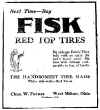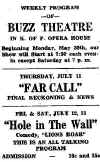 rville
was in the hospital at Fort Meyer for seven weeks. Charley Taylor and Charley Furnas
packed up and went home to Dayton — and Charley Furnas apparently left the employ of
the Wright Brothers then and there. There are several accounts as to why he did so. One
maintains that he had thrown in with the Wrights only to learn to fly, and the Fort Meyer
accident dissuaded him. Another tells that his father, Tanzy Furnas, was horrified by
reports of the accident and put pressure on Charley to get out of the airplane business
before he was killed, too. Tanzy had, in fact, expressed his displeasure to Orville for
taking Charley aloft. Both versions may have some validity — certainly, if Charley
and his family were unaware of the dangers of early aviation, the Fort Meyer accident
brought the point home. In fact, Charley Taylor — Furnas' comrade in arms — had
been slated to fly with Orville on the day of the accident, but had been bumped by
Selfridge. Both men undoubtedly felt the hot breath of the Angel of Death at that moment.
And if Charley's original ambitions were to become a pilot, later events would prove his
decision not to pursue this career was a wise one. The Wrights trained nine men for their
first exhibition team in 1910. By 1912, six had died in crashes. rville
was in the hospital at Fort Meyer for seven weeks. Charley Taylor and Charley Furnas
packed up and went home to Dayton — and Charley Furnas apparently left the employ of
the Wright Brothers then and there. There are several accounts as to why he did so. One
maintains that he had thrown in with the Wrights only to learn to fly, and the Fort Meyer
accident dissuaded him. Another tells that his father, Tanzy Furnas, was horrified by
reports of the accident and put pressure on Charley to get out of the airplane business
before he was killed, too. Tanzy had, in fact, expressed his displeasure to Orville for
taking Charley aloft. Both versions may have some validity — certainly, if Charley
and his family were unaware of the dangers of early aviation, the Fort Meyer accident
brought the point home. In fact, Charley Taylor — Furnas' comrade in arms — had
been slated to fly with Orville on the day of the accident, but had been bumped by
Selfridge. Both men undoubtedly felt the hot breath of the Angel of Death at that moment.
And if Charley's original ambitions were to become a pilot, later events would prove his
decision not to pursue this career was a wise one. The Wrights trained nine men for their
first exhibition team in 1910. By 1912, six had died in crashes.But Charley could have
stayed on as a mechanic without ever learning to fly. Probably, his decision to leave was
more for lack of work than any other reason. With the big push to build the Military Flyer
over, Charley Taylor could easily keep up with the bicycle business himself.
Orville went straight from Fort Meyer to join his brother Wilbur in Europe, and was
there for the better part of a year before the two of them came back to manufacture more
airplanes. By that time, Charley would have moved on to another job from economic
necessity.
Shortly after his aeronautical adventures, Charley returned to West Milton, Ohio. He
became an automobile mechanic, operating the Furnas Garage on the corner of what is now
Washington Street and Route 571. On June 3, 1913, he married Letitia Washington, and the
couple lived at 223 North Miami Street, not far from his parents' home. They had no
children.
Charley had a reputation as a crackerjack mechanic. According to one former customer,
he could"...fix anything in nothing flat." However, he was known to like to take
a drink or two. Customers reported that he would leave the shop for this or that and
apparently "forget" to come back. In the late teens or early twenties, he bought
a vaudeville theater, "Pythian Hall" in the old opera house at 103 N. Miami
Street, and began to show silent movies. A little later, he also operated the Buzz Theater
at 15 S. Miami, another movie house. This was the time of the Great Experiment,
Prohibition, and the Buzz Theater was the site of West Milton's "speakeasy."
(There's still a peephole in one of the upstairs doors.) It's probably a safe bet that
Charley either ran the speakeasy or was on the board of directors. Whatever his
involvement with the illegal alcohol trade of the Roaring Twenties, he never lost his
fascination for technological breakthroughs. In 1929, Charley installed a "talking
machine" in the Buzz Theater to show talkies. |

Charley and his wife Letitia lived on the left side of this double in West
Milton, Ohio.
An ad for a tire sale at the Furnas Garage.

An ad for Charley's Buzz Theater. "Hole in the Wall" was the first
talkie ever shown in Charley's home town.
|
![]()
![]()
![]()
![]()